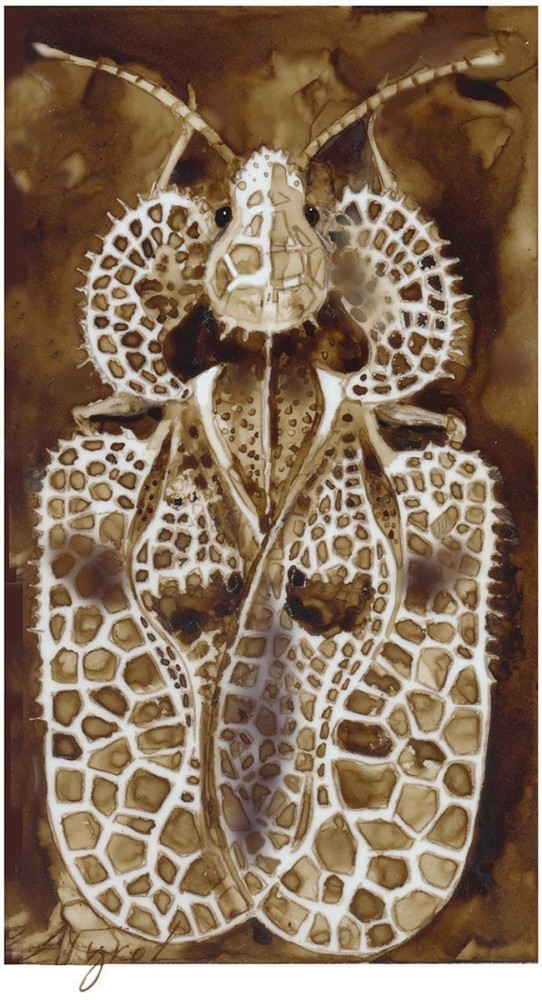
My students and I have pit-trapped invertebrates in Camp Johnson in Colchester, Vermont, annually since 2006. We sink liquid-filled plastic tubes into the ground to intercept forest-floor invertebrates as they forage in the leaf litter. With regular sampling at a single site, one quickly learns “the usual suspects.” But occasionally we encounter “unusual suspects” – rare forest-floor invertebrates, or more often, invertebrates not typically found on the forest floor at all. Such was the case last fall when a most picturesque little insect made its way into a student’s sample tube.
Measuring scarcely an eighth of an inch, the insect appeared ornately decorated from top to tail in the style of a Baroque aristocrat, a particularly small aristocrat. Its dramatically lacy wings extended straight back from angular front corners before rounding at the back end to entirely conceal the abdomen. Its legs were partly hidden by elaborate semicircular flaps growing out to the sides from the thorax and matching the lacy wing texture. The “outfit” was completed by a lace hood. Viewed from above, the only evidence that the insect had a head at all was a pair of antennae sprouting forward from beneath the hood before elbowing left and right.
We quickly determined that our specimen was a lace bug: a true bug (Hemiptera) and not to be confused with the lacewing, a beneficial insect in the order Neuroptera. Determining which species proved more challenging. Tingidae – the lace bug family – includes more than 2,000 species, and identification keys usually include advice to record the plant species from which the specimen was collected; advice we had failed to follow. Lace bugs are specialists on particular host plants, and knowing that the specimen I collected this morning came from a basswood tree almost certainly confirms that it is Gargaphia tiliae, the basswood lace bug. The azalea lace bug may well be munching through your garden as you read, but only through your azaleas.
It is sometimes surprising to recognize the damage that even a very tiny bug’s munching can do to prized plants and trees. All lace bugs feed by piercing leaf cells, injecting enzymes, and then sucking out the cell contents. Although both nymphs and adults attack leaves from below, the resulting whitening of the leaves is visible from above and may be the first indication of damage.
Because lace bugs and their host plants coevolved over eons, plant defenses have often evolved to minimize damage. However, when the eastern sycamore lace bug (Corythucha ciliate), a North American species, was introduced to Europe in the 1960s, it became a spectacularly invasive pest on the comparatively defenseless London plane tree (Platanus × acerifolia), which is a hybrid between the lace bug’s natural host American sycamore (Platanus occidentalis) and an Asian species (Platanus orientalis).
Lace bug nymphs and adults feed cheek-by-jowl on the undersides of leaves. The leaves initially are stippled with white patches where the leaf cells have been killed. As infestations progress, formerly green sycamore or plane tree leaves take on a bronze color that can progress to premature senescence and leaf loss. Extreme infestations can defoliate trees and are more likely to occur in dry weather. Recent climate models suggest that warming will produce ideal conditions to increase population growth of sycamore lace bugs, leading to more frequent defoliations. According to literature from North Carolina Cooperative Extension, occasional defoliation of otherwise healthy sycamore trees is of little consequence to long-term tree health.
I was interested to learn how an insect common in tree leaves might make its way into one of our forest-floor pit traps; a quick study of the lace bug’s life cycle provided the answer. Nymphs, which look like spiny versions of adults but lack the lacy accoutrements, hatch from eggs laid into the undersides of leaves. After feeding, growing, and molting five times as nymphs, the resulting lace-clad adults continue to feed and live beneath leaves. The cycle repeats every four to six weeks during summer. In winter, adults of some species, such as the sycamore lace bug, seek shelter in bark crevices, while others overwinter in leaf litter.
If you suspect your sycamore – or more likely azalea – is hosting lace bugs, a far more reliable way to detect them is by searching beneath the leaves for excrement. The insects attach frass to lower leaf surfaces and they look a lot like small spots of brown varnish. Before launching your search, I recommend purchasing an inexpensive clip-on macro lens – for your smartphone. Your investment will open a window to the microscopic world, and who knows, perhaps you’ll be rewarded by an encounter with a dramatically elegant lace bug; viewing this six-legged masterpiece should not be reserved just for students with microscopes.

